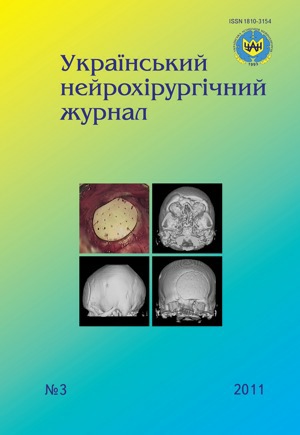Results of restorative surgical treatment of patients with spinal cord total damage
DOI:
https://doi.org/10.25305/unj.57790Keywords:
spinal cord injury, restorative treatment, quality of lifeAbstract
Restorative surgical treatment of injured persons with spinal cord total damage is directed to their self-care abilities and care after them improving, pain syndrome and spasticity decreasing.
Summarized results of treatment of 79 patients with consequences of spinal cord trauma are given. Treatment results were estimated by analyzing the degree of movements and sensitive function renewing, pain syndrome and spasticity intensity and control of pelvic organs function.
After surgery movements renewing was observed in 17.7% patients, spasticity decreasing — in 75%, intensity of pain syndrome decreasing — in 91.3%, pelvic organs function was improvement in 50.6% cases.
In patients with consequences of spinal cord total damage quality of life after surgery is improved by pain syndrome correction, spasticity reducing and control of pelvic organs functions improving.
References
Urgent surgical decompression compared to methylprednisolone for the treatment of acute spinal cord injury: a randomized prospective study in beagle dogs / R.S. Rabinowitz, J.C. Eck, C.M. Harper Jr. , et al. // Spine. — 2008. — V.33. — P.2260–2268.
Fehlings M.G. The role and timing of early decompression for cervical spinal cord injury: Update with a review of recent clinical evidence / M.G. Fehlings, R.G. Perrin // Injury. — 2005. — V.36. — P.13–26.
Tsymbaliuk V, Chebotariova L, Iaminskiy I. Embrional tissue transplantation as a method of spinal cord recovery after experimental injury. Ukrainian Neurosurgical Journal. 2002;(1):69-76.
Krishnan R.V. Spinal cord injury repair research: a new combination treatment strategy / R.V. Krishnan, R. Muthusamy, V. Sankar // Int. J. Neurosci. — 2001. — V.108. — P.201–207.
Complete spinal cord injury treatment using autologous bone marrow cell transplantation and bone marrow stimulation with granulocyte macrophage-colony stimulating factor: Phase I/II clinical trial / S. Yoon, Y. Shim, Y. Park, et al. // Eur. Spine J. — 2009. — V.20. — P.1456–1469.
Functional recovery of paraplegic rats and motor axon regeneration in their spinal cord by olfactory ensheanthing glia / A. Ramon-Cueto, M.I. Cordero, F.F. Santos-Benito, et al. // Neuron. — 2000. — V.25. — P.425–435.
The ability of human Schwann cell grafts to promote regeneration in the transected nude rat spinal cord / J.D. Guest, A. Rao, O. Olson, et al. // Exp. Neurol. — 1997. — V.148. — P.502–522.
Advances in the management of spinal cord injury / R. Gupta, M.E. Bathen, A.D. Levi, et al. // J. Am. Acad. Orthop. Surg. — 2010. — V.18. — P.210–222.
Facilitation of stepping with epidural stimulation in spinal rats: Role of Sensory Input / I. Lavrov, G. Courtine, C. Dy, et al. // J. Neurosci. — 2008. — V.28. — P.7774–7783.
Oscillating field stimulation for complete spinal cord injury in humans: a Phase 1 trial / S. Shapiro, R. Borgens, R. Pascuzzi // J. Neurosurg. Spine. — 2005. — V.2. — P.3–10.
Coffey R.J. Neurostimulation for chronic noncancer pain: an evaluation of the clinical evidence and recommendations for future trial designs / R.J. Coffey, A.M. Lozano // J. Neurosurg. — 2006. — V.105. — Р.175–189.
McCaig C.D. Neurotrophins enhance electric field-directed growth cone guidance and directed nerve branching / C.D. McCaig, L. Sagster, R. Stewart // Dev. Dyn. — 2000. — V.217. — P.299–308.
Цимбалюк В.І. Реконструктивно-відновна хірургія спинного мозку / В.І. Цимбалюк, Ю.Я. Ямінський. — К.: Авіцена, 2009. — 59 с.
Hamid S. Role of electrical stimulation for rehabilitation and regeneration after spinal cord injury: an overview / S. Hamid, R. Hayek // Eur. Spine. — 2008. — V.17. — P.1256–1269.
Oakley J.C. Spinal cord stimulation: mechanisms of action // J.C. Oakley, J.P. Prager // Spine. — 2002. — V.27, N22. — P.2574–2583.
Downloads
Published
How to Cite
Issue
Section
License
Copyright (c) 2011 Vitaliy Tsymbaliuk, Iuriy Iaminskiy

This work is licensed under a Creative Commons Attribution 4.0 International License.
Ukrainian Neurosurgical Journal abides by the CREATIVE COMMONS copyright rights and permissions for open access journals.
Authors, who are published in this Journal, agree to the following conditions:
1. The authors reserve the right to authorship of the work and pass the first publication right of this work to the Journal under the terms of Creative Commons Attribution License, which allows others to freely distribute the published research with the obligatory reference to the authors of the original work and the first publication of the work in this Journal.
2. The authors have the right to conclude separate supplement agreements that relate to non-exclusive work distribution in the form of which it has been published by the Journal (for example, to upload the work to the online storage of the Journal or publish it as part of a monograph), provided that the reference to the first publication of the work in this Journal is included.









